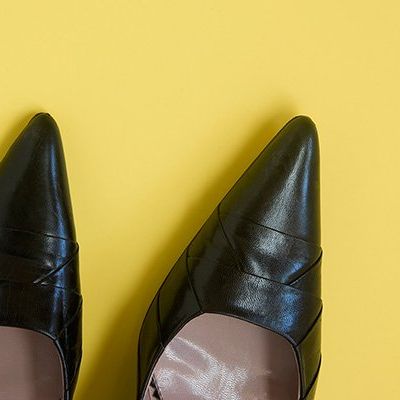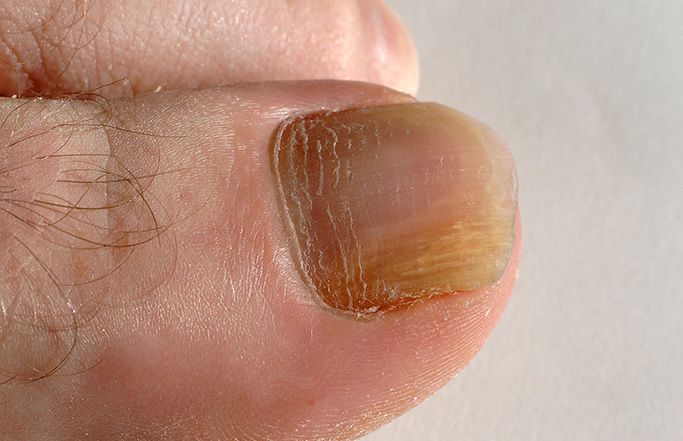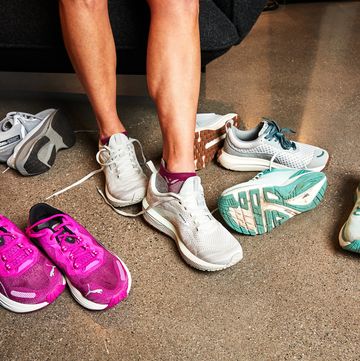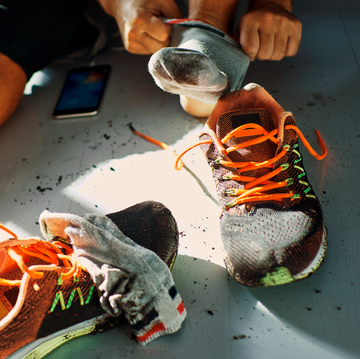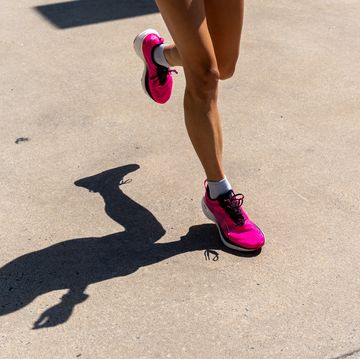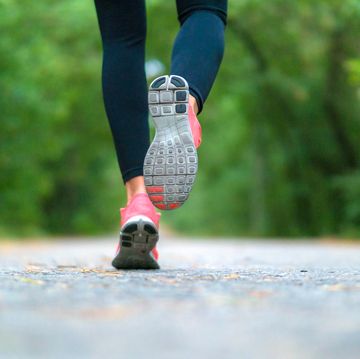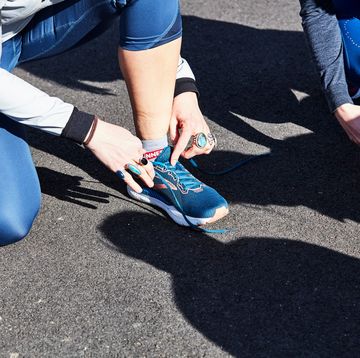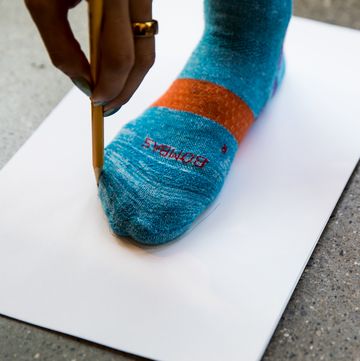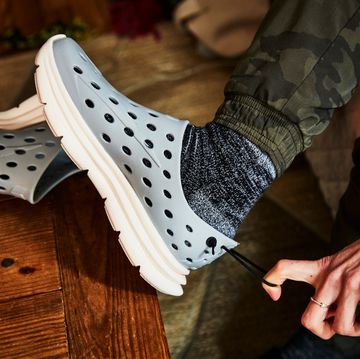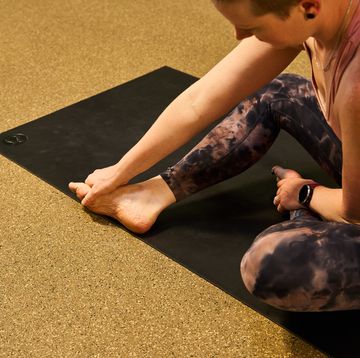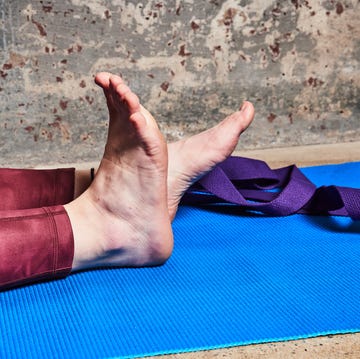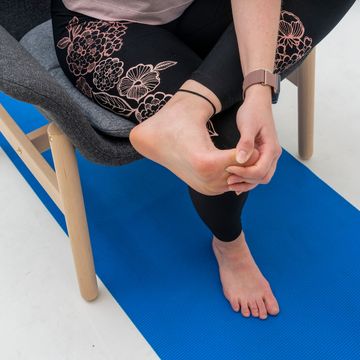You’re hard on your feet, likely taking at least 8,000 steps a day. (Find out how to make that 10,000.) And let’s be honest, how much TLC do you really give them except for an occasional pedicure? It’s time to start paying more attention. Begin here: We asked podiatrists what you can do to keep your feet in top condition. Consider their advice a step in the right direction.
Don’t go barefoot in a public shower.
You’ve heard it before, but it’s worth repeating: Gym showers and locker-room floors are a big-time breeding ground for the fungus that causes athlete’s foot, so be sure to wear flip-flops or water shoes, says Casey Ann Pidich, DPM, an associate at Big Apple Foot & Ankle Care in New York City. Take extra care drying your feet, too, working the towel in between your toes. By the same token, if you book a pedicure, grab the first appointment of the day when the tubs are likely to be the cleanest. (Here are the 10 worst germ hot spots that you touch everyday.)
RELATED: You Will Never Shower Barefoot at the Gym After You Read This (WARNING: The photo is gross!)
Your feet can clue you in to your overall health.
For example, if the hair on your toes suddenly disappears and the skin on your feet gets thinner or shiner, peripheral arterial disease (PAD)—poor circulation caused by a buildup of plaque in the leg arteries—may be to blame, says Amanda Meszaros, DPM, a podiatrist in Oberlin, OH. PAD is a major red flag for heart problems or a stroke because clogged arteries in the legs are usually associated with blockages elsewhere in the body. Also look out for extremely dry skin and foot ulcers that don’t heal; they may be triggered by undiagnosed diabetes since high blood glucose levels decrease sweat and oil production, points out Meszaros.
Pointy pumps are the worst.
Shoes that push the big toe into smaller toes set you up for bunions, bumps that form over the bone at the base of the big toe, says Pidich. The skin overlying the bunion may become red, irritated, and swollen, making walking painful. Your ideal high heels: ones with a wide toe box and heels under 2 inches.
The length of your toes is a big deal.
If your second toe is longer than your first toe (that’s the case for an estimated 20 to 30 percent of Americans), you’re at increased risk for bunions, hammer toes (ones that are bent downward), and even back problems due to how you distribute pressure throughout your body, says Robert F. Weiss, DPM, director of the Foot & Ankle Institute at Stamford Hospital in Connecticut. “All the weight should push off your first toe, but when the second one is longer, it rolls and flattens, causing all kind of foot problems,” he explains. If you do have this condition (called Morton’s toe), talk to your podiatrist about the best kind of footwear for the shape of your feet, since ill-fitting shoes make the condition worse.
RELATED: Subscribe now and SAVE for Runner’s World magazine.
Toenail fungus is so stubborn.
If your toenails have started to discolor or are becoming thicker and more brittle, chances are fungus is to blame. “While nails clear up in time by taking antifungal pills, your risk of a recurrence is high so I recommend a topical cream to help prevent it,” says Timothy Swartz, DPM, Kaiser Permanente’s chief of podiatry for the mid-Atlantic region. Keeping your feet dry and changing out of sweaty socks can help prevent the fungus—which thrives in warm, moist environments and can invade your skin through tiny cuts or the small separation between the nail and nail bed—from rearing its ugly head in the first place.
RELATED: 10 Things You Can Do With Aloe Vera
It’s not your imagination: Your feet really are getting bigger.
Even if you didn’t put on weight, chances are you went up at least a half-size in the past decade. Feet become both longer and wider as you age because the tendons and ligaments that link tiny bones lose elasticity. Get your feet measured at least once a year so you know your true size, suggests Swartz. Wearing shoes that don’t fit properly can cause more than discomfort—it can create or accelerate a bunion or cause blisters, among other issues.
WATCH: Common Foot Problems With Dr. Jordan Metzl
People with diabetes need to take special care of their feet.
If you have diabetes, check your feet daily for blisters, cuts, redness, and ulcers. If wounds are neglected, you might get an infection, which could lead to serious consequences, including amputation. It’s not rare: Every year, more than 70,000 Americans with diabetes lose a foot. “Diabetics who lose a foot have a 50 percent chance of dying within 5 years,” warns Bradley A. Levitt, DPM, a podiatrist in Virginia Beach.
RELATED: 10 Things Your Feet Say About Your Health
If you keep spraining your ankle, you’re not a klutz.
Some people are just genetically predisposed to weak ankles, says Swartz. Strengthen your injury-prone ankles with these 3 moves.
You might not be lacing your sneakers right.
If you have high arches and get redness and pain on the top of your feet, skip the two middle holes in your lacing and loop them vertically on the sides of your shoes instead, suggests podiatrists at the Center for Podiatric Care and Sports Medicine in New York City. You’ll lose a little stability, but what you gain in comfort will make it worthwhile.
Use deodorant down there.
Yep, the same kind of roll-on that you apply to your armpits can help prevent the foul smells caused by the sweat glands in your feet.
The article 10 Things Podiatrists Wish Everyone Knew About Their Feet originally appeared on Prevention.
The former senior editor at Parents who started the brand’s awards programs, Karen Cicero is a seasoned journalist who specializes in travel, book, lifestyle and food coverage.Cicero has visited almost every state with her family (look out Wyoming, she’s coming for you next!) She recently presented at several travel industry conferences, including PRSA and the Mid-Atlantic Tourism Alliance. A mom who goes overboard for all the holidays, Cicero lives in the Christmas city itself: Bethlehem, Pennsylvania.
